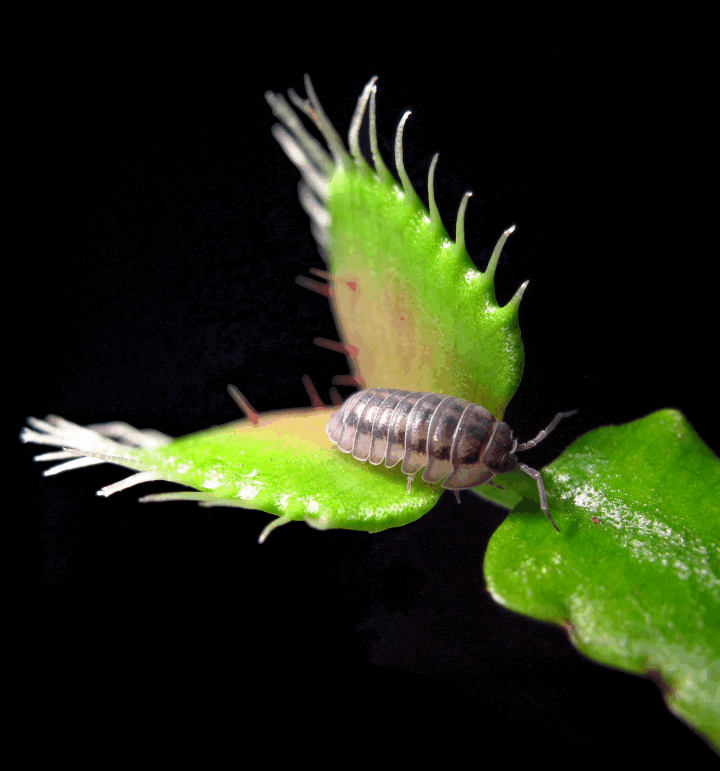The Venus flytrap takes only 100 milliseconds to catch its prey. Once their leaves, which have been transformed into snap traps, have closed, insects can no longer escape. Scientists from the Institute of Structural Mechanics at the University of Stuttgart and the Plant Biomechanics Group at the University of Freiburg used biomechanical experiments and virtual Venus flytraps to analyze in detail how the two lobes of the trap move. The Stuttgart structural engineers Renate Sachse and Prof. Dr. Manfred Bischoff as well as the Freiburg biologists Dr. Anna Westermeier, Max Mylo, Prof. Dr. Thomas Speck, and Dr. Simon Poppinga showed that the traps of the carnivorous plant are under mechanical prestress for this purpose. In addition, the three tissue layers of each lobe have to deform according to a special pattern. The scientists published their findings in the internationally highly respected journal Proceedings of the National Academy of Sciences USA in June 2020.
- Original publication
-
Sachse R., Westermeier A., Mylo M., Nadashi J., Bischoff M., Speck T., Poppinga S. (2020) Snapping mechanics of the Venus flytrap (Dionaea muscipula). In: Proceedings of the National Academy of Sciences USA, doi: 10.1073/pnas.2002707117
Virtual traps: According to nature’s design and without a real-world example
In order to gain a better understanding of these processes, the biologists from Freiburg measured the strain curves of the interior and exterior surfaces of the trap on the real plant using digital 3D image correlation methods. The Stuttgart team then implemented the results into idealized simulation models of the plant. Using finite-element simulations, they constructed numerous virtual traps that differ in their tissue layer setups and in the mechanical behavior of the layers. Such analyses can be used to investigate different designs of the snap trap and scenarios that are either not measurable on real plants or do not even exist in nature.
Investigating the morphing process
The diet of the Venus flytrap consists mainly of crawling insects. When the animals touch the sensory hairs inside the trap twice within about twenty seconds, it snaps shut. Aspects such as how the trap perceives its prey and how it differentiates potential prey from a raindrop falling into the trap were already well known to scientists. However, the precise morphing process of the halves of the trap remained largely unknown.
Simulation results lead to new insights
Initially, the simulations did not show the expected snapping behavior as it occurs in nature. After mechanical considerations, the engineering research group in Stuttgart put forward the hypothesis that, in the real plant, the trap in its opened state must be under prestress. After implementing this specification into the simulation, the typical snapping behavior became apparent. The biologists in Freiburg were able to confirm the hypothesis by means of dehydration tests on real plants. Only well-watered traps are able to snap shut quickly and correctly by releasing this prestress. Watering the plant changes the pressure in the cells and with it the behavior of the tissue. This enables the plant to activate the characteristic snap-through mechanism for closing, which allows the trap to snap shut quickly and thus establish a catch rate.
Video of a simulation, showing the snap mechanism and the strain curve over one half of the trap.
About the project
Bischoff and his team are involved in the University of Stuttgart’s two Clusters of Excellence, “Data-Integrated Simulation Science” and “Integrative Computational Design and Construction for Architecture”, as well as in the Collaborative Research Center 1244 “Adaptive Skins and Structures for the Built Environment of Tomorrow”. The cooperation with the Freiburg biologists is embedded in a series of research projects in which the Stuttgart architects Prof. Jan Knippers and Prof. Achim Menges are also involved. Speck and Mylo are members of the “Living, Adaptive and Energy Autonomous Material Systems” (livMatS) Cluster of Excellence at the University of Freiburg. The study was funded by the German Research Foundation, by the Baden-Wuerttemberg Ministry of Science, Research and the Arts as part of the “BioElast” project, and by the “Joint Research Network on Advanced Materials and Systems”, which was established by BASF SE and the University of Freiburg.
Contact
Renate Sachse, Institute of Structural Mechanics, University of Stuttgart, phone: 0711/685 66575; E-Mail.
Services around publishing
The team of the University Library gives advice on funding issues and publication opportunities, including the publishing of books. It is important to contact the team at an early stage, especially in the case of projects of the German Research Foundation.
Contact:
Stefan Drößler, Open Access Officer, phone: +49 711 685-83509, E-mail.
Further information and advice.
The following institutions (among others) will be happy to help you with writing scientific texts:
If you have recently published a paper that would be suitable for presentation as part of the Publizieren! series, please send a brief summary of the topic to University Communications and give a reason why the paper should be included in the series.


